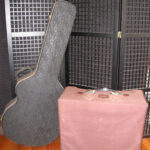Learning to play the electric guitar can feel like an exciting journey, especially with the vast resources available today. Unlike aspiring guitarists from decades past, you now have access to online lessons, guitar tablature sites, detailed gear reviews, and vibrant online communities connecting players at every skill level.
While guidance from a guitar teacher offers undeniable benefits, teaching yourself electric guitar is absolutely achievable. All it takes is your personal drive, a sprinkle of motivation, and a commitment to consistent practice to keep you progressing.
Ready to plug in and play? Keep reading for essential tips and tricks on how to Learn Electric Guitar by yourself.
Getting Started: Essential Gear for Electric Guitar Beginners
The Electric Guitar: Choosing Your First Instrument
While dreaming of a vintage Gibson Les Paul might be tempting, starting your guitar journey with practical and reliable gear is key for smooth progress. Investing in a decent quality guitar that plays well and stays in tune will significantly enhance your learning experience in numerous ways.
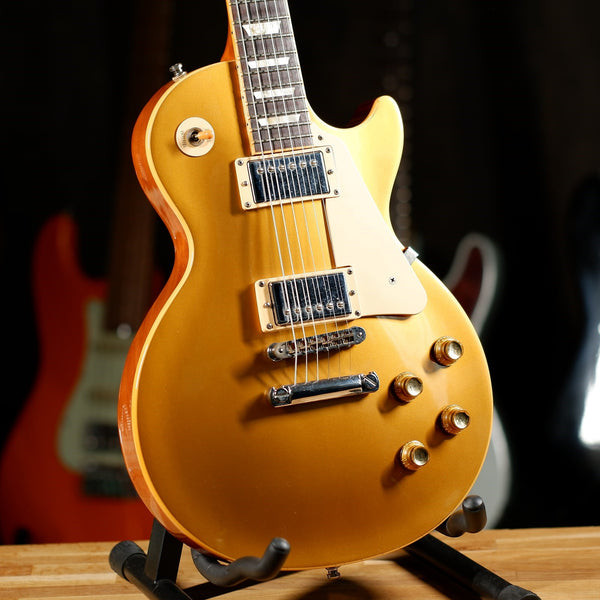 Beginner electric guitar setup
Beginner electric guitar setup
Image alt text: A beginner electric guitar setup featuring a Fender Squier Stratocaster, a small practice amplifier, guitar cable, picks, and a strap, ideal for learning electric guitar.
While every guitar possesses unique characteristics, certain brands are known for producing reliable beginner-friendly instruments. Brands like Fender Squier, Epiphone, and Yamaha Pacifica are excellent starting points. Remember that extremely cheap guitars often compromise on quality, potentially hindering your learning due to poor sound and playability. Investing a bit more upfront in a reputable beginner model will pay off in the long run.
Amplifiers: Unleashing Your Electric Guitar Sound
Alongside your guitar, a functional amplifier and a dependable guitar cable are essential. Modern technology offers a fantastic range of affordable “modeling amplifiers.” These amps are particularly beneficial for beginners as they digitally replicate the sounds of many iconic and contemporary amplifiers.
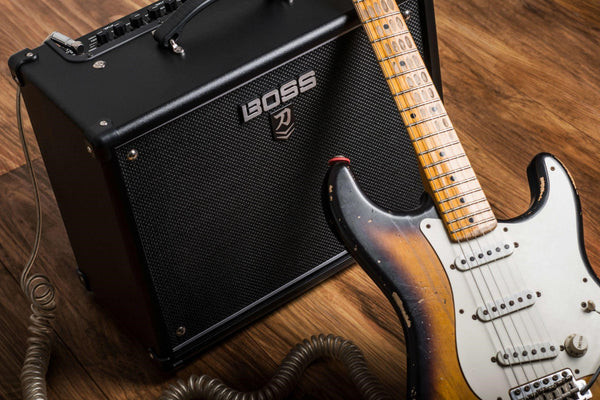 Modeling amplifier for electric guitar practice
Modeling amplifier for electric guitar practice
Image alt text: A close-up of a modeling amplifier showcasing various amp models and effects, a versatile tool for beginners to explore different electric guitar tones while learning.
Modeling amps allow you to experiment with a wide spectrum of tones without breaking the bank. As you progress and discover your preferred amp sounds, you can always upgrade to higher-end amplifiers later.
Essential Accessories: Picks, Straps, and More
To complete your beginner setup, you’ll need guitar picks and a comfortable strap. Consider also purchasing strap locks to secure your guitar strap, preventing accidental drops, especially when you start playing more energetically!
Guitar picks are available in various shapes, sizes, and thicknesses. Exploring a sample pack of different picks is a great way to discover which styles feel most comfortable and suit your playing style. Experiment with different thicknesses from thin to thick to see how they affect your tone and control.
Understanding Your Electric Guitar and Gear
Take the time to thoroughly understand your new equipment. Reading the owner’s manuals for your guitar, amplifier, and any other accessories is invaluable. Learning the ins and outs of your gear empowers you to take greater control over your sound and equips you to troubleshoot issues effectively.
Exploring the Anatomy of Your Electric Guitar
Familiarize yourself with the different parts of your electric guitar. While designs vary, most electric guitars share common components: a body, neck, frets, strings, pickups, tuning pegs, nut, bridge, and knobs and switches.
Understanding the function of each knob and switch is crucial for shaping your guitar tone. For instance, a Stratocaster-style guitar typically features single-coil pickups, a five-way selector switch, and volume and tone control knobs.
Single-coil pickups, standard on Stratocasters, consist of a single magnet wrapped in copper wire with six pole pieces.
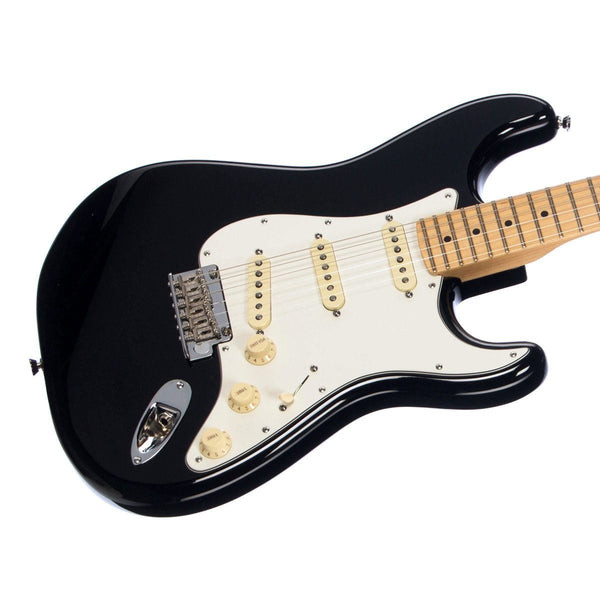 Single coil pickup on a stratocaster electric guitar
Single coil pickup on a stratocaster electric guitar
Image alt text: A detailed view of a single-coil pickup on an electric guitar, highlighting its construction and components, explaining a key element in learning electric guitar tone.
Compared to humbucking pickups (which use two magnets wrapped together), single-coil pickups produce a brighter, thinner, and more articulate sound.
Pickup Switching and Tone Shaping
Stratocaster-style guitars usually have three single-coil pickups, while guitars like Les Pauls or SGs typically feature two humbucking pickups. The five-way switch on a Stratocaster allows you to select different pickup combinations.
Positioning the switch all the way to the left activates the neck pickup (closest to the neck), producing a warmer tone. Switching it to the far right selects the bridge pickup (closest to the bridge), resulting in a brighter, more aggressive sound. The positions in between offer combinations of these pickups, creating a variety of tonal colors.
On a two-pickup humbucker guitar, the toggle switch generally has three positions: neck pickup, both pickups together, and bridge pickup. These positions might be labeled “rhythm” (neck) and “treble” (bridge), but don’t be limited by these labels. Experiment with both settings for rhythm and lead playing to discover what suits your style.
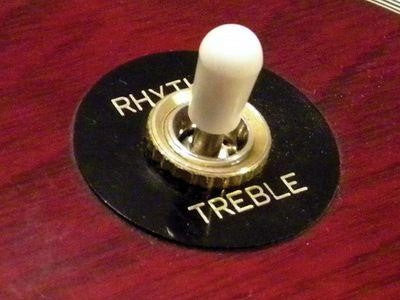 Toggle switch on an electric guitar selecting pickups
Toggle switch on an electric guitar selecting pickups
Image alt text: A close-up of a toggle switch on an electric guitar, demonstrating how to select different pickups for varying tones, an important aspect of learning electric guitar sound control.
In the middle position (both pickups), you can use the individual volume knobs for each pickup to blend their signals. For example, with both pickups engaged, you can set the neck pickup volume to 50% and the bridge pickup volume to 100%, or vice versa, to create unique tonal textures. Exploring these tonal possibilities is key to unlocking the full creative potential of your electric guitar.
Tuning Your Guitar and Changing Strings
Learning to tune your guitar is fundamental at every stage of your guitar journey. Fortunately, numerous high-quality smartphone apps are available for accurate and easy guitar tuning.
Clip-on tuners that attach to your guitar’s headstock are also inexpensive and convenient. These are especially useful for quick tuning adjustments between songs during practice or performance.
For a more professional setup, pedal tuners can be integrated into your pedalboard signal chain. Guitarists typically place a tuner pedal as the first pedal in their signal chain. A signal chain refers to the order in which your guitar signal passes through effects pedals before reaching the amplifier. While pedal order is a matter of personal preference, placing your tuner first is generally a safe bet for accurate tuning.
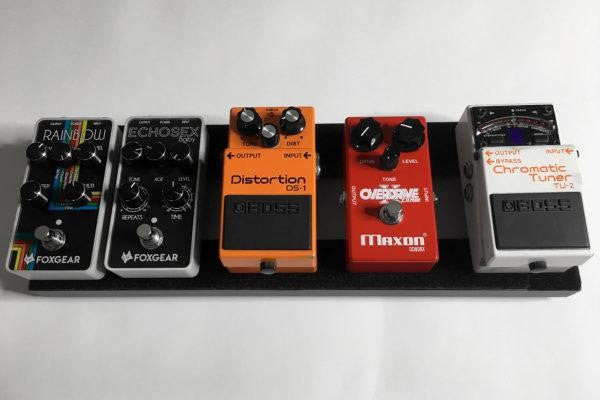 Overdrive pedal example for electric guitar effects
Overdrive pedal example for electric guitar effects
Image alt text: An overdrive pedal, illustrating a common type of effects pedal used in electric guitar signal chains, showcasing an element of gear progression after learning the basics.
Learning how to change your guitar strings is another essential skill. Many helpful tutorial videos online demonstrate this process. Experiment with different string gauges and types to find what you prefer. String gauge refers to the thickness of the strings. Lighter gauge strings are generally easier for beginners to play and bend, while some more advanced players prefer heavier strings for a thicker tone and more stable intonation. Similar to guitar picks, try various string gauges to discover your personal preference.
Mastering Guitar Tabs and Chord Charts
The easiest way to begin playing songs and familiarize yourself with the electric guitar is by learning to read guitar tablature (tabs) and chord charts. You don’t need prior knowledge of traditional musical notation to start playing electric guitar!
Guitar Tabs: Your Gateway to Songs
Guitar tablature is a simplified notation system specifically for guitar. It uses six horizontal lines representing the six guitar strings, similar to the staff in standard music notation.
Tabs are read from bottom to top. The bottom line represents the low E string (6th string), and the top line represents the high E string (1st string). Numbers on the lines indicate the fret to be played on that string. For example, a “1” on the top line means play the first fret of the high E string.
Image alt text: A guitar tab example showing the number “1” on the top line, indicating playing the first fret on the high E string, demonstrating a fundamental of learning guitar tabs.
A “5” on the bottom line signifies playing the fifth fret on the low E string.
Image alt text: A guitar tab example showing the number “5” on the bottom line, indicating playing the fifth fret on the low E string, further explaining how to read guitar tabs.
Chord Charts: Visualizing Guitar Chords
Learning to read chord charts is another quick and effective method for self-teaching electric guitar. Many chord charts include chord diagrams, visually illustrating how to play the chords needed for a specific song.
Chord diagrams are pictorial representations of chord shapes on the guitar fretboard and are relatively easy to understand. Imagine looking down at your guitar fretboard from the bridge towards the headstock. The six vertical lines represent the six guitar strings, with the low E string on the left and the high E string on the right. Horizontal lines represent the frets.
This diagram illustrates a basic chord diagram for an E major chord in the open position:
Image alt text: A chord diagram for an open E major chord, visually representing finger placement on the fretboard, a key visual aid for beginners learning electric guitar chords.
In this diagram, dots indicate where to place your fingers: second fret of the A string, second fret of the D string, and first fret of the G string. Press down these frets with your fretting hand and strum all the strings with your picking hand to play the E major chord. Consistent practice with chord charts and diagrams will help you memorize chord shapes, making it increasingly easier to learn songs quickly.
Leveraging the Internet for Electric Guitar Learning
Today’s guitarist has access to an unparalleled wealth of online information and resources. It truly is a golden age for learning guitar. The internet provides access to a vast amount of learning materials. However, be discerning and prioritize quality resources. Not everything you find online is accurate or helpful.
Consider investing in a structured online guitar course and follow it diligently. This provides a clear learning path, allows you to track your progress, and helps you distinguish reliable information from less credible sources. Following a disciplined learning plan is the surest route to consistent guitar development.
Choose a Structured Program and Stick With It
Resist the temptation to jump between random YouTube videos. While YouTube offers a vast library of guitar content, these channels often lack a structured curriculum. Avoid feeling overwhelmed by the sheer volume of available courses. Select one program that resonates with you, commit to it fully, and move on to other topics after completion.
Guitar Head offers excellent, step-by-step programs designed for guitarists. Our course, “Guitar Exercises for Beginners,” provides a dual benefit by guiding you through learning electric guitar while establishing a solid practice routine to accelerate your progress. The course focuses on maximizing skill development with just 10 minutes of daily practice. Explore the course here.
 Guitar Head course interface on a laptop screen
Guitar Head course interface on a laptop screen
Image alt text: A laptop screen displaying the Guitar Head online guitar course interface, showcasing a structured learning platform for those wanting to learn electric guitar effectively.
Setting Goals and Maintaining Focus
Self-learning and consistent progress require self-motivation and discipline. Setting achievable short-term and long-term goals is incredibly beneficial. For example, aim to learn the five forms of the minor pentatonic scale within five months, dedicating one month to each form. This is a realistic goal that can be accomplished without excessive time or effort.
Establishing a Practice Routine
Developing a consistent practice routine and adhering to it is crucial. Find a dedicated time each day for practice and create a schedule to use your time efficiently, rather than just aimlessly “noodling” for an hour. Start with warm-up exercises, then practice scales, followed by chords, and finally songs. This is just a sample structure; you can create countless variations to suit your specific goals. Consistency is the key to effective practice.
The Power of Listening: Expand Your Musical Horizons
Listening to music is paramount to becoming a proficient musician. You need to develop an ear for how a guitar should sound in the hands of a skilled player. Continuously seek out new music to keep your inspiration fueled and your development progressing. Often, stagnant listening habits can lead to plateaus in your guitar playing.
Learn from Guitar Masters: Interviews and Live Performances
Seek out interviews with your favorite guitarists to gain insights into their musical approaches and mindsets. Delve into their thought processes and try to understand what makes their unique sound so distinctive. Watch live performances, or even better, attend concerts whenever possible to experience the dynamic atmosphere and energy of live music.
Mastering the Essential Basics
Regardless of your preferred musical genre, mastering basic open position and barre chord shapes, along with fundamental major, minor, and pentatonic scale patterns, is imperative. These are the foundational building blocks of guitar technique. Studying them will develop strong fundamental skills applicable to almost any playing situation. Furthermore, understanding basic chords and scales enhances your ability to communicate effectively about guitar with fellow musicians.
Chords in Every Key
Learning to play guitar chords in all twelve keys is essential. Guitar makes this task more approachable than instruments like piano. On guitar, the CAGED system allows you to move various chord shapes across the fretboard. For example, the “C shape” chord, when rooted on the third fret of the A string, becomes a C major chord. Shifting this shape up two frets, with the root on the fifth fret of the A string, transforms it into a D major chord. This principle applies to all shapes within the CAGED system.
Scales: Your Improv Tool Kit
Just as movable patterns exist for chords, movable patterns also exist for major, minor, and pentatonic scales. To play the minor pentatonic scale in all twelve keys, you only need to learn one pattern. This pattern can then be shifted up and down the fretboard to match any key for improvisation. The same concept applies to major and minor scale patterns. This movability makes learning guitar scales significantly more accessible compared to instruments like piano, where each scale requires a unique fingering pattern.
Developing Specific Guitar Techniques
Identify the signature techniques of your favorite guitarists and practice incorporating them into your own playing. Basic techniques include slides, bends, hammer-ons, pull-offs, legato runs, sweep picking, tapping, and more. Explore different picking styles like alternate picking, hybrid picking, and fingerpicking. The vast array of guitar-specific techniques offers endless possibilities for exploration. Focus on mastering the techniques that resonate most with your musical interests.
Learning Songs: Internalizing Guitar Language
As a beginner guitarist, learning as many songs, riffs, licks, and solos as possible is highly beneficial. This is how you internalize the “language” of the guitar fretboard. Like all instruments, guitar playing has characteristic techniques and approaches. Learning these guitar-specific mannerisms early on is crucial for internalizing and mastering them, forming a foundation upon which you can build your unique style.
The Metronome: Your Rhythm Training Partner
Using a metronome will significantly elevate your playing. The metronome is an invaluable practice tool, offering numerous beneficial applications. Fortunately, many excellent metronome apps are available for free download on smartphones.
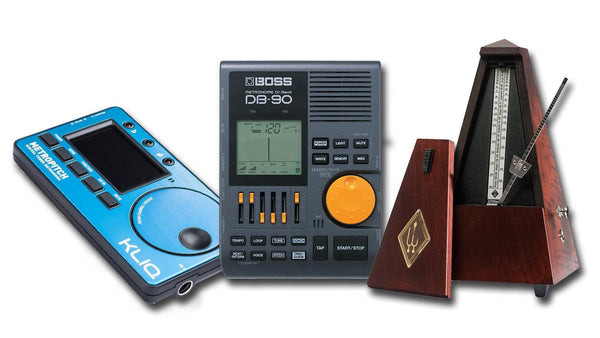 Metronome app on a smartphone for guitar practice
Metronome app on a smartphone for guitar practice
Image alt text: A smartphone displaying a metronome app, highlighting a crucial tool for developing timing and rhythm when learning electric guitar.
Metronome Practice Ideas
The most basic way to use a metronome is with clicks on all four beats of a measure. However, you can vary your practice by setting the metronome to click on just one beat or on the off-beats. Think of metronome practice as a workout for your rhythm. The more you practice with it, the stronger your timing and rhythmic feel will become.
Recording and Evaluating Your Playing
Utilize a voice memo app on your phone to record yourself practicing electric guitar. Listen back critically to identify areas for improvement and aspects of your playing that you are satisfied with.
Self-Reflection: Key to Improvement
Listening back to your recordings is a powerful tool for self-reflection on your progress and skills. Honest self-assessment while listening will accelerate your progress towards your guitar goals.
Embracing Music Theory: Demystifying Musical Concepts
Music theory is essentially a set of concepts, tools, and a shared language that musicians use to describe musical patterns and tendencies. Don’t be intimidated by music theory.
Music Theory: An Asset, Not a Hindrance
Many self-taught musicians mistakenly believe that learning music theory will stifle their creativity and make their playing rigid. The opposite is true! Ignoring music theory actually limits your understanding and access to a vast universe of musical knowledge.
Finding Your Guitar Community
Perhaps the most vital aspect of self-learning electric guitar is finding a community of guitarists and musicians you enjoy connecting with and learning from. Engaging with other musicians about music is the best way to stay inspired, discover new ideas, and broaden your musical horizons.
 Group of guitarists jamming together in a community setting
Group of guitarists jamming together in a community setting
Image alt text: A group of diverse guitarists jamming together, emphasizing the importance of community and collaboration in learning electric guitar and fostering musical growth.
Whether your community is primarily online or in-person, interacting with fellow guitarists will accelerate your development and keep you motivated. Who knows, you might even form your next band!
Considering Online Guitar Courses for Structured Learning
While abundant learning materials are readily available, and anyone can learn electric guitar independently, YouTube might not be the optimal choice for structured guitar education. YouTube often lacks the necessary structure and guidance for effective learning, potentially leading to scattered learning and limited progress.
Investing in a quality online guitar course provides structure, guidance, and a clear path to learning electric guitar more efficiently and enjoyably. Consider exploring our course, “Guitar Exercises for Beginners”. This course features seven chapters and over 100 exercises designed to take you from beginner to proficient player. The course’s unique approach allows you to significantly enhance your guitar skills with just 10 minutes of daily practice. Explore the course here.

